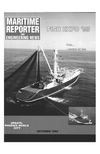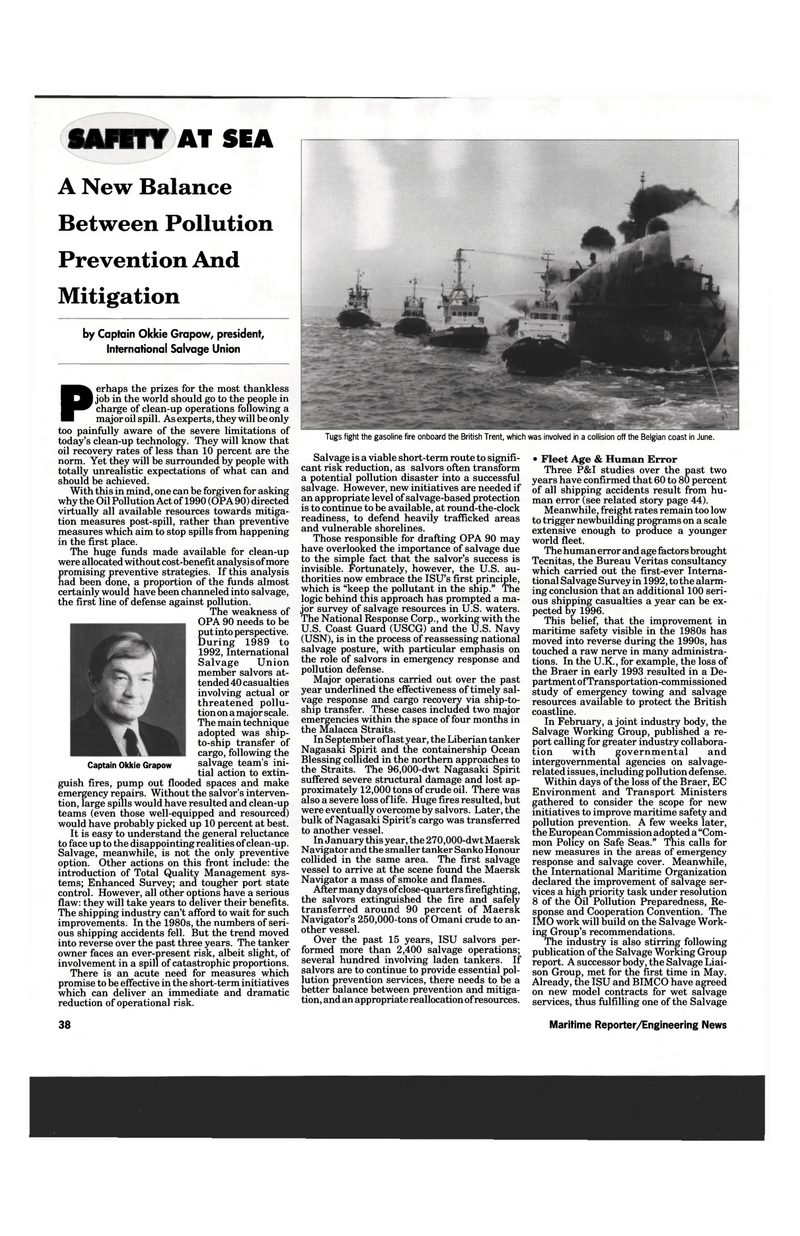
Page 36: of Maritime Reporter Magazine (October 1993)
Read this page in Pdf, Flash or Html5 edition of October 1993 Maritime Reporter Magazine
Tugs fight the gasoline fire onboard the British Trent, which was involved in a collision off the Belgian coast in June.
AT SEA
A New Balance
Between Pollution
Prevention And
Mitigation by Captain Okkie Grapow, president,
International Salvage Union
Perhaps the prizes for the most thankless job in the world should go to the people in charge of clean-up operations following a major oil spill. As experts, they will be only too painfully aware of the severe limitations of today's clean-up technology. They will know that oil recovery rates of less than 10 percent are the norm. Yet they will be surrounded by people with totally unrealistic expectations of what can and should be achieved.
With this in mind, one can be forgiven for asking why the Oil Pollution Act of 1990 (OPA 90) directed virtually all available resources towards mitiga- tion measures post-spill, rather than preventive measures which aim to stop spills from happening in the first place.
The huge funds made available for clean-up were allocated without cost-benefit analysis of more promising preventive strategies. If this analysis had been done, a proportion of the funds almost certainly would have been channeled into salvage, the first line of defense against pollution.
The weakness of
OPA 90 needs to be put into perspective.
During 1989 to 1992, International
Salvage Union member salvors at- tended 40 casualties involving actual or threatened pollu- tion on a major scale.
The main technique adopted was ship- to-ship transfer of cargo, following the salvage team's ini- tial action to extin- guish fires, pump out flooded spaces and make emergency repairs. Without the salvor's interven- tion, large spills would have resulted and clean-up teams (even those well-equipped and resourced) would have probably picked up 10 percent at best.
It is easy to understand the general reluctance to face up to the disappointing realities of clean-up.
Salvage, meanwhile, is not the only preventive option. Other actions on this front include: the introduction of Total Quality Management sys- tems; Enhanced Survey; and tougher port state control. However, all other options have a serious flaw: they will take years to deliver their benefits.
The shipping industry can't afford to wait for such improvements. In the 1980s, the numbers of seri- ous shipping accidents fell. But the trend moved into reverse over the past three years. The tanker owner faces an ever-present risk, albeit slight, of involvement in a spill of catastrophic proportions.
There is an acute need for measures which promise to be effective in the short-term initiatives which can deliver an immediate and dramatic reduction of operational risk. 38
Salvage is a viable short-term route to signifi- cant risk reduction, as salvors often transform a potential pollution disaster into a successful salvage. However, new initiatives are needed if an appropriate level of salvage-based protection is to continue to be available, at round-the-clock readiness, to defend heavily trafficked areas and vulnerable shorelines.
Those responsible for drafting OPA 90 may have overlooked the importance of salvage due to the simple fact that the salvor's success is invisible. Fortunately, however, the U.S. au- thorities now embrace the ISU's first principle, which is "keep the pollutant in the ship." The logic behind this approach has prompted a ma- jor survey of salvage resources in U.S. waters.
The National Response Corp., working with the
U.S. Coast Guard (USCG) and the U.S. Navy (USN), is in the process of reassessing national salvage posture, with particular emphasis on the role of salvors in emergency response and pollution defense.
Major operations carried out over the past year underlined the effectiveness of timely sal- vage response and cargo recovery via ship-to- ship transfer. These cases included two major emergencies within the space of four months in the Malacca Straits.
In September of last year, the Liberian tanker
Nagasaki Spirit and the containership Ocean
Blessing collided in the northern approaches to the Straits. The 96,000-dwt Nagasaki Spirit suffered severe structural damage and lost ap- proximately 12,000 tons of crude oil. There was also a severe loss of life. Huge fires resulted, but were eventually overcome by salvors. Later, the bulk of Nagasaki Spirit's cargo was transferred to another vessel.
In January this year, the 270,000-dwt Maersk
Navigator and the smaller tanker Sanko Honour collided in the same area. The first salvage vessel to arrive at the scene found the Maersk
Navigator a mass of smoke and flames.
After many days of close-quarters firefighting, the salvors extinguished the fire and safely transferred around 90 percent of Maersk
Navigator's 250,000-tons of Omani crude to an- other vessel.
Over the past 15 years, ISU salvors per- formed more than 2,400 salvage operations; several hundred involving laden tankers. If salvors are to continue to provide essential pol- lution prevention services, there needs to be a better balance between prevention and mitiga- tion, and an appropriate reallocation of resources. • Fleet Age & Human Error
Three P&I studies over the past two years have confirmed that 60 to 80 percent of all shipping accidents result from hu- man error (see related story page 44).
Meanwhile, freight rates remain too low to trigger newbuilding programs on a scale extensive enough to produce a younger world fleet.
The human error and age factors brought
Tecnitas, the Bureau Veritas consultancy which carried out the first-ever Interna- tional Salvage Survey in 1992, to the alarm- ing conclusion that an additional 100 seri- ous shipping casualties a year can be ex- pected by 1996.
This belief, that the improvement in maritime safety visible in the 1980s has moved into reverse during the 1990s, has touched a raw nerve in many administra- tions. In the U.K., for example, the loss of the Braer in early 1993 resulted in a De- partment ofTransportation-commissioned study of emergency towing and salvage resources available to protect the British coastline.
In February, a joint industry body, the
Salvage Working Group, published a re- port calling for greater industry collabora- tion with governmental and intergovernmental agencies on salvage- related issues, including pollution defense.
Within days of the loss of the Braer, EC
Environment and Transport Ministers gathered to consider the scope for new initiatives to improve maritime safety and pollution prevention. A few weeks later, the European Commission adopted a "Com- mon Policy on Safe Seas." This calls for new measures in the areas of emergency response and salvage cover. Meanwhile, the International Maritime Organization declared the improvement of salvage ser- vices a high priority task under resolution 8 of the Oil Pollution Preparedness, Re- sponse and Cooperation Convention. The
IMO work will build on the Salvage Work- ing Group's recommendations.
The industry is also stirring following publication of the Salvage Working Group report. A successor body, the Salvage Liai- son Group, met for the first time in May.
Already, the ISU and BIMCO have agreed on new model contracts for wet salvage services, thus fulfilling one of the Salvage
Maritime Reporter/Engineering News
SAFETY
Captain Okkie Grapow

 35
35

 37
37
